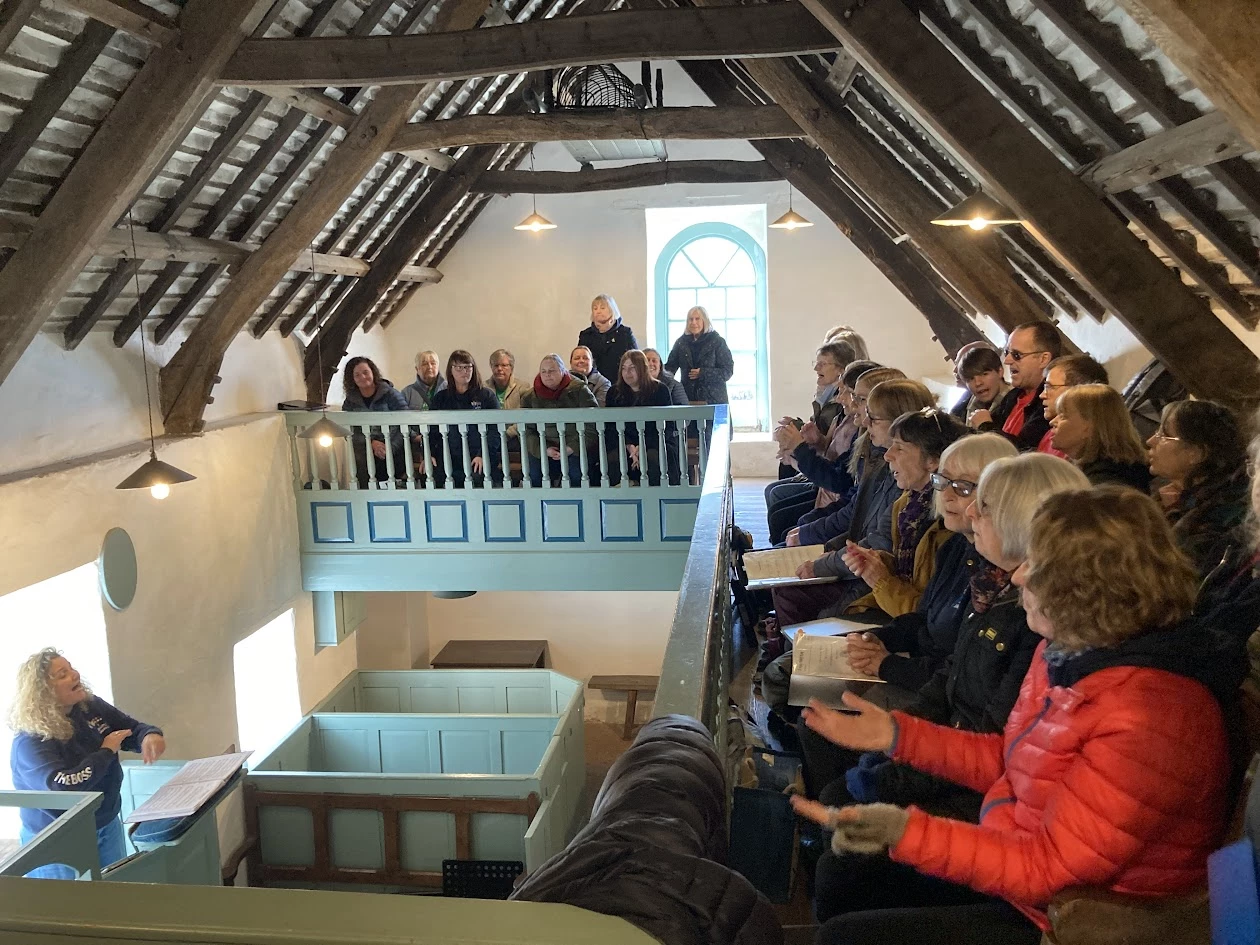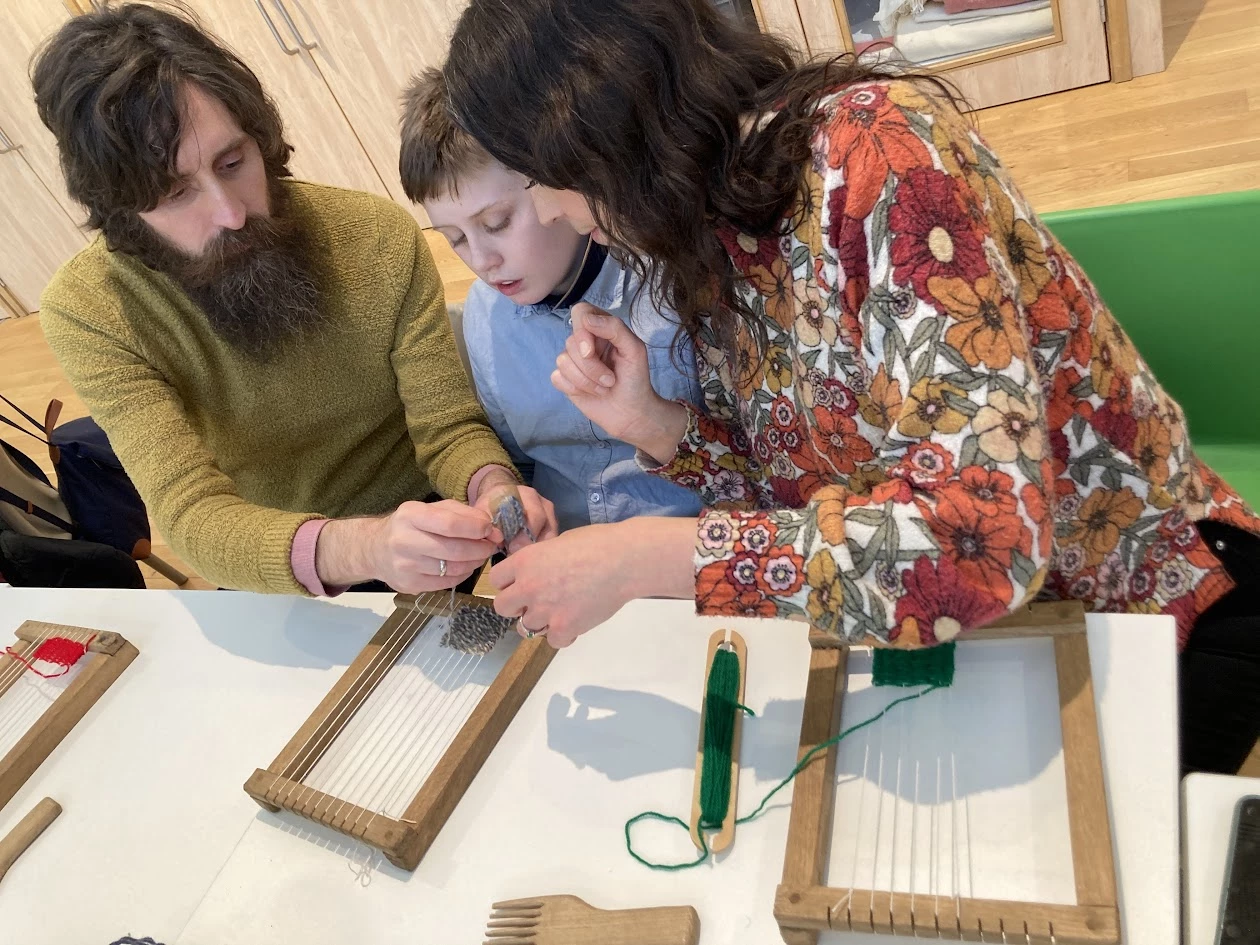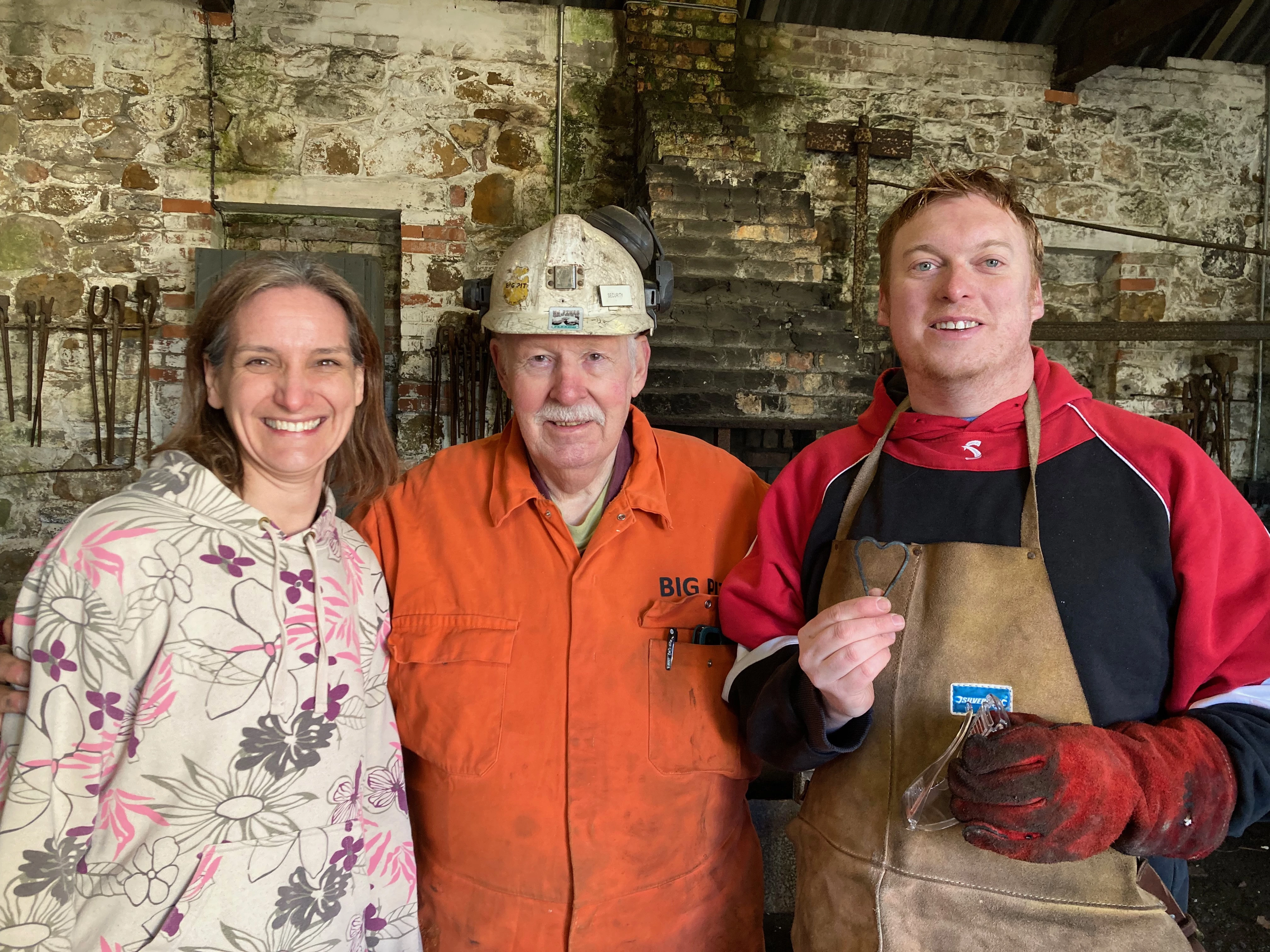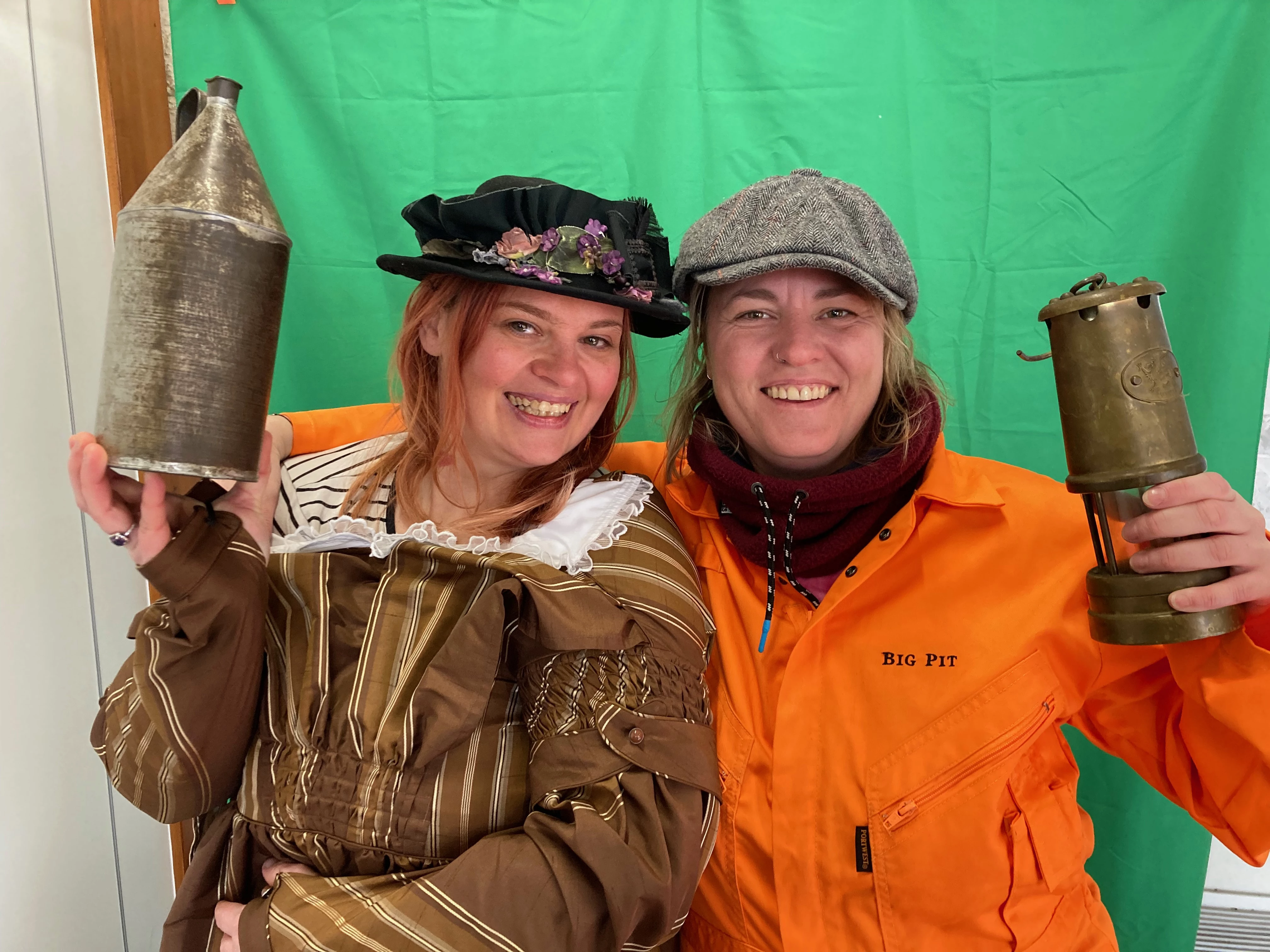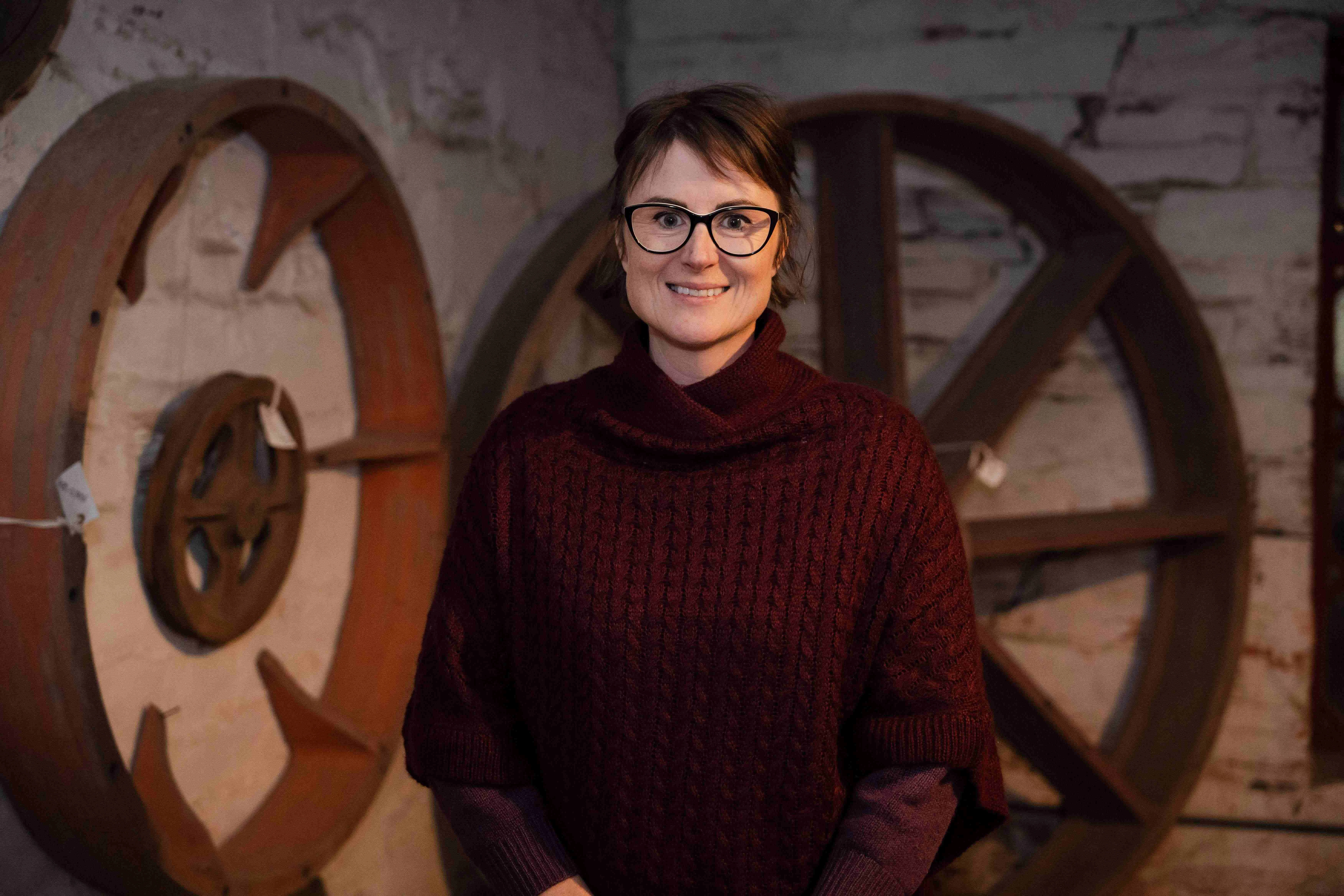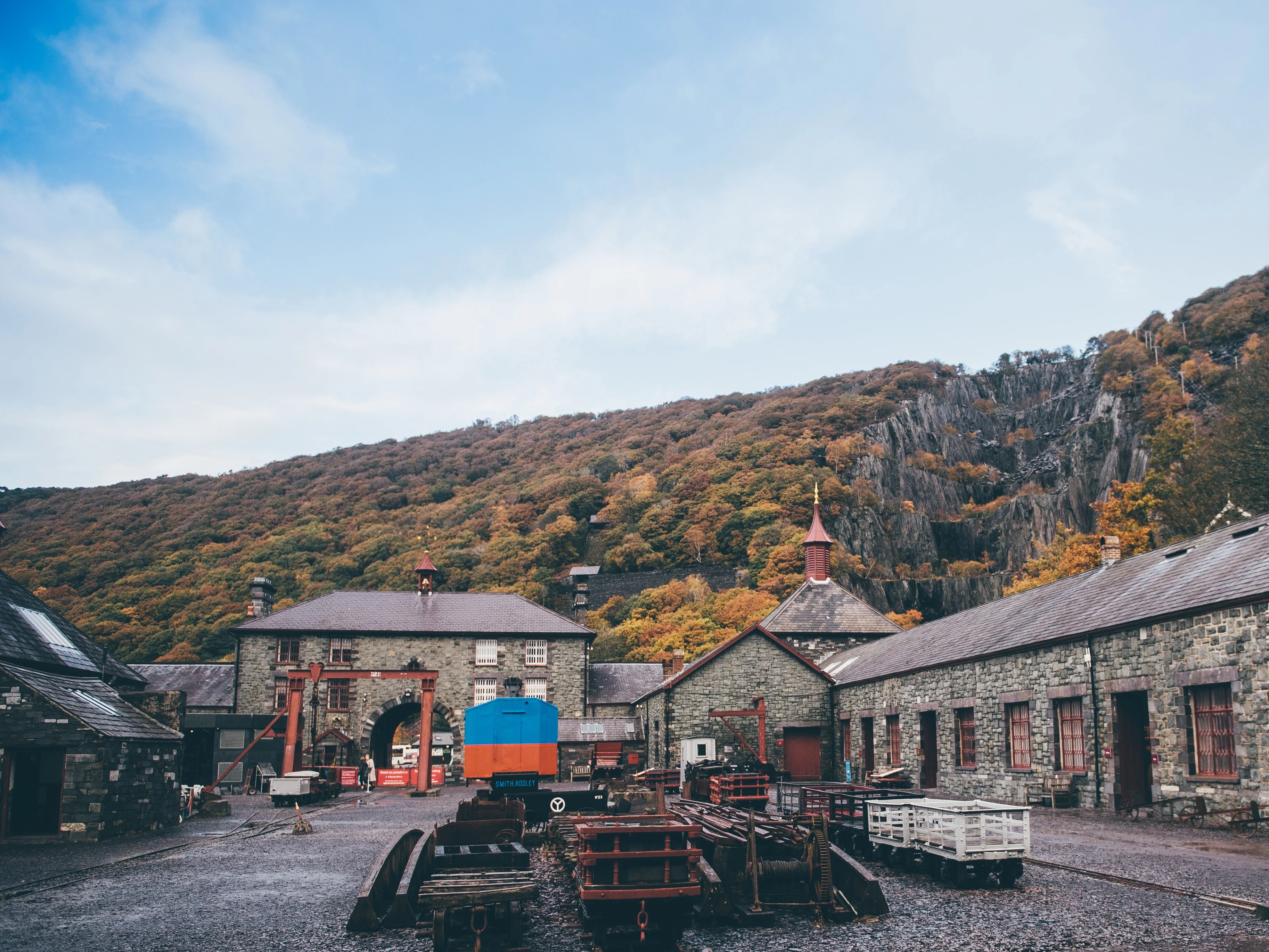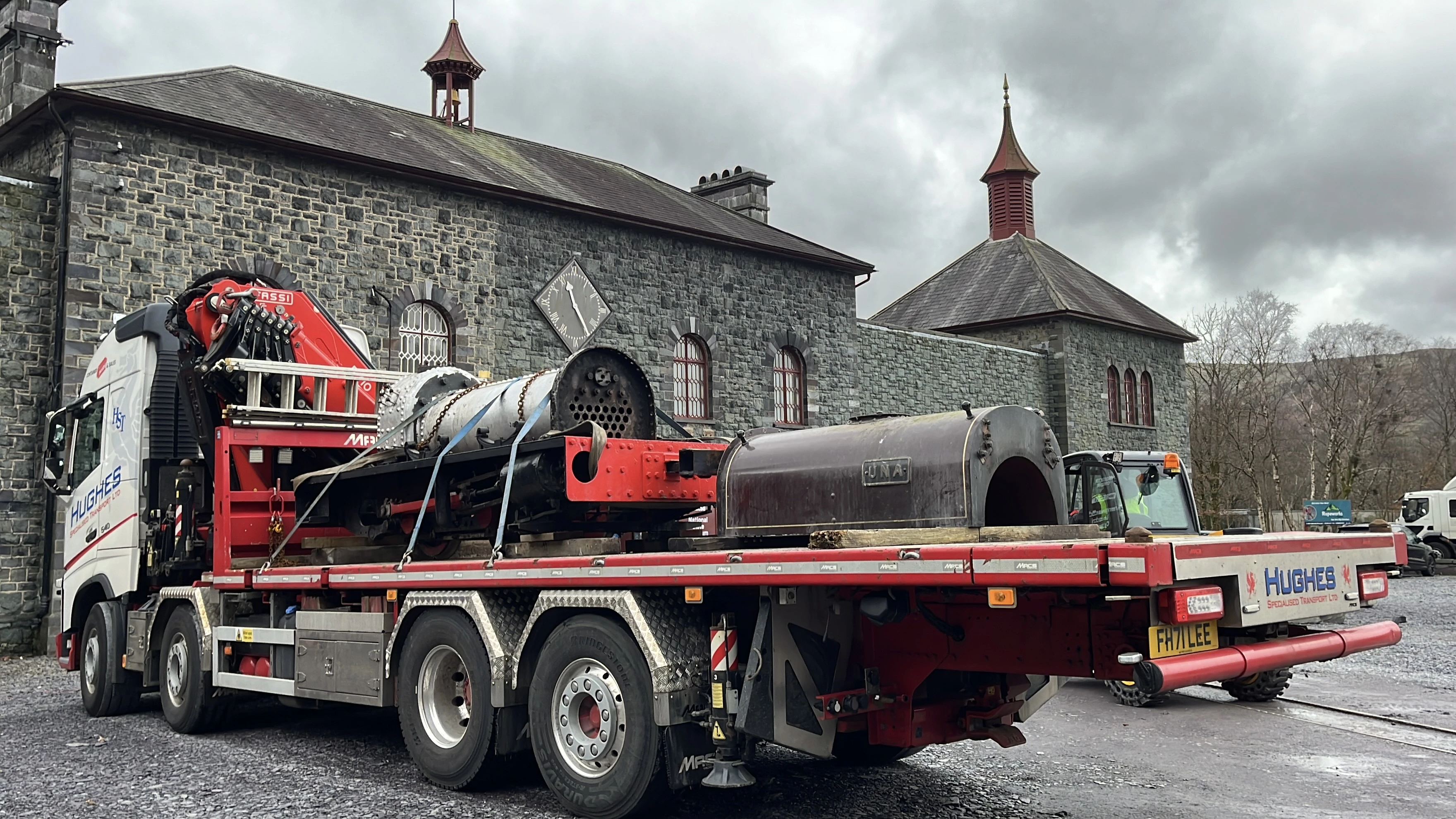Dathlu lles meddwl cadarnhaol drwy ymgysylltu â threftadaeth, creadigrwydd a chymuned ar Ddiwrnod Santes Dwynwen:
Ar 25 Ionawr 2025, dathlodd Amgueddfa Cymru Ddiwrnod Santes Dwynwen, sef diwrnod Nawddsant Cariad Cymru, gyda gŵyl i ddathlu lles meddwl cadarnhaol gyda chefnogaeth creadigrwydd, treftadaeth a chymuned.
Ar draws ein saith amgueddfa, cynhaliwyd gwahanol weithgareddau a pherfformiadau, a ddyluniwyd i ddileu straen, gwella hwyliau a helpu pobl i ymdopi â heriau bob dydd. Roedd y rhain yn cynnwys gweithdai celfyddydau creadigol a ysbrydolwyd gan ein casgliadau, datganiadau cerddoriaeth, perfformiadau côr, sesiynau blasu gwaith gof a gweithdai barddoniaeth. Yn ogystal â hyn, fe wnaethon ni hefyd gynnal marchnadoedd gwybodaeth yn Sain Ffagan a Big Pit lle gallai sefydliadau sy’n cynnig gwasanaethau i gefnogi lles pobl ymgysylltu â’r cyhoedd a rhannu gwybodaeth a chyngor.
Sain Ffagan
Yn Sain Ffagan fe wnaethon ni groesawu Côr Cymunedol Sally’s Angels a buon nhw’n canu ar y Llwyfan Cymunedol yng nghyntedd yr amgueddfa wrth i ymwelwyr gyrraedd yn y bore. Yn dilyn hyn cafwyd perfformiadau ar safle Capel Pen-rhiw a Sefydliad y Gweithwyr Oakdale yn ddiweddarach yn y dydd. Perfformiodd y côr amrywiaeth o ganeuon yn Gymraeg ac yn Saesneg, gan gynnwys perfformiad twymgalon o’r gân fythol boblogaidd, Calon Lân. Ymatebodd ymwelwyr yn dda iawn i’r awyrgylch hapus a gwresog a gafwyd gan y côr drwy gydol y dydd. Diolch i holl aelodau gwych y côr a helpodd i’w wneud yn ddigwyddiad mor arbennig.
Cynhaliwyd marchnad stondinau gwybodaeth yn y prif gyntedd hefyd, gyda sawl sefydliad yn cynnal gweithgareddau crefft galw heibio, fel addurno fframiau cardfwrdd siâp calon. Roedd y gweithgareddau yma’n boblogaidd iawn gyda phlant ac oedolion fel ei gilydd ac yn galluogi’r sefydliadau partner i siarad ag ymwelwyr am eu gwasanaethau yn fwy manwl wrth i bobl dreulio amser ar y stondinau yn cymryd rhan yn y gweithgareddau crefft oedd ar gael. Roedd wyth stondin i gyd, yn cynnwys Canolfan Ganser Felindre, Oasis Caerdydd, Prosiect Hapus (Iechyd Cyhoeddus Cymru), grŵp cymorth dementia Memory Jar, Mudiad Meithrin/Cymraeg i Blant, Gwasanaeth Ambiwlans Cymru a Platfform – yr elusen iechyd meddwl, yn ogystal â stondin gan yr Amgueddfa yn hyrwyddo rhaglen Iechyd a Lles Amgueddfa Cymru, yn enwedig y Prosiect Amgueddfeydd yn Ysbrydoli Atgofion.
Rydyn ni’n amcangyfrif bod y farchnad wedi ymgysylltu â thua 165 o bobl drwy gydol y dydd.
Yn ystod y dydd cynhaliwyd gweithgareddau amrywiol yn Sain Ffagan gyda’r nod o ddarparu amgylchedd ymlaciol i fwynhau ac ymgysylltu â chasgliadau’r amgueddfa mewn ffordd greadigol. Roedd y rhain yn cynnwys gweithdai crefft gwlân a gwehyddu gan ddefnyddio ein hatgynhyrchiadau o wyddiau llaw o’r Oes Haearn, teithiau cerdded myfyriol ym myd natur yn archwilio gofodau tu allan, fflora a ffawna’r amgueddfa, a gweithdy creu Llwy Garu bapur eich hun wedi’i hysbrydoli gan y casgliad Llwyau Caru yn oriel Gweithdy, wedi’i gynnal gan yr artist Nia Skyrme.
Roedd y gweithdai gwehyddu lle roedd pobl yn gallu creu eu nod llyfr gwlân eu hunain i fynd adref gyda nhw yn boblogaidd iawn. Roedd yr adborth yn gadarnhaol iawn gyda llawer o bobl yn dweud pa mor ymlaciol a myfyriol oedd y gweithgaredd iddyn nhw a pha mor hyfryd oedd hi i wneud rhywbeth drostyn nhw eu hunain wrth dreulio amser gyda theulu a ffrindiau. Dywedodd llawer o rieni a gymerodd ran yn y sesiwn pa mor hyfryd oedd hi i wneud rhywbeth y gallen nhw roi cynnig arno eu hunain, gyda’u plant, gan ddysgu sgil newydd a mwynhau’r broses greadigol gyda’i gilydd. Roedd y plant a gymerodd ran i’w gweld yn canolbwyntio ac yn y mwynhau’r gweithdai ac yn gadael yn falch iawn gyda’u llyfrnodau gwlanog!
Soniodd y bobl a gymerodd ran ar y teithiau natur myfyriol pa mor ymlaciol a heddychlon oedd y profiad iddyn nhw, a’u bod hefyd yn gweld y teithiau’n ddiddorol ac yn llawn gwybodaeth. Rhannodd Ian Daniel, a arweiniodd y teithiau cerdded, dechnegau meddwlgarwch gyda phobl i fynd gyda nhw a’u defnyddio yn eu bywydau bob dydd, yn ogystal â ffeithiau diddorol am y fflora a’r ffawna ar eu taith gerdded.
Cafodd yr artist Nia Skyrme, a fu’n arwain y gweithgaredd Llwy Garu yn y Gweithdy, brynhawn prysur iawn gydag o leiaf 95 o bobl yn galw draw i gymryd rhan yn ystod y sesiwn. Gwnaeth y cyfranogwyr lwyau caru papur hardd yn cynrychioli beth oedd yn bwysig iddyn nhw, wedi’u hysbrydoli gan yr arddangosfa hyfryd yn oriel Gweithdy drws nesaf i’r sesiwn.
Roedd teuluoedd â phlant hŷn yn gallu cymryd rhan yn y gweithgaredd celf hygyrch yma gyda’i gilydd, ac roedd rhieni plant ifanc iawn yn gallu mwynhau gweithgaredd creadigol yn heddychlon tra roedd eu babanod yn cysgu. Roedd hi’n ffordd hyfryd o annog ymwelwyr i gysylltu â’r casgliadau mewn ffordd wahanol; roedd yr adborth yn gadarnhaol iawn.
Roedd y tywydd yn hyfryd ar 25 Ionawr. Roedd yr haul yn gwenu drwy’r dydd, gan ddenu llawer o ymwelwyr i Sain Ffagan – llawer mwy nag y bydden ni’n ei ddisgwyl fel arfer ar ddiwedd mis Ionawr. Rhoddodd hyn hwb mawr i’r ŵyl a chaniatáu i ni hyrwyddo ‘amgueddfeydd er lles’ i gynulleidfa eang.
Big Pit
Yn Big Pit roedd amrywiaeth o weithgareddau i’w harchebu a gweithgareddau galw heibio.
Drwy gydol y dydd, bu Len Howell, sydd â dros 50 mlynedd o brofiad o weithio fel gof mewn pwll glo, yn arwain sesiynau gwaith gof yn yr efail yn Big Pit. Bwriad rhain oedd helpu dynion i ymdopi â straen drwy gymryd rhan mewn gweithgaredd corfforol a ‘tharo’r einion yn galed’. Gydag arweiniad, roedd y cyfranogwyr yn gallu gweithio gyda dur poeth a gwneud calon fach i fynd adref gyda nhw.
Arweiniodd y bardd Patrick Jones weithdai ‘Ysgrifennu er Lles’ er mwyn ceisio curo diflastod mis Ionawr. Drwy weithdy hwyliog ac ysgafn o ddarllen, gwrando a thrafod cerddi, bu cyfranogwyr hefyd yn cymryd rhan mewn ymarferion ysgrifennu a gynlluniwyd i godi hwyliau. Dywedodd pob un o’r cyfranogwyr fod lefel eu bodlonrwydd a’u hapusrwydd wedi codi erbyn diwedd y gweithdy, ac roedd pawb yn hapus i rannu eu meddyliau a’u teimladau mewn ffilm fer a wnaed ar y diwrnod.
Cymerodd teuluoedd ran mewn gweithgaredd ‘Creu Llwy Garu’, a dysgu am y gwahanol symbolau ac ystyron, cyn dylunio a chreu eu llwy eu hunain. Rhoddodd y gweithgaredd difyr yma gyfle i bobl ymlacio a sgwrsio ag arweinwyr y gweithdai, a manteisiodd llawer o bobl ar y cyfle hefyd i wisgo gwisgoedd mwyngloddio yn erbyn cefnlen hanesyddol, wrth archwilio’r thema ‘Cynefin’.
Daeth nifer o sefydliadau sy’n gallu helpu gyda lles meddwl cadarnhaol a chyfeirio pobl at ragor o wybodaeth i’r farchnad ar y diwrnod.
Cafodd Andy’s Man Club, grŵp cerdded Take a Stroll Torfaen, Sport in Mind, Torfaen Talks CIC, Cymdeithas Alzheimer’s Cymru ac Iechyd Cyhoeddus Cymru i gyd gyfleoedd i ymgysylltu â’r cyhoedd a hyrwyddo’r cymorth, y cyngor a’r arweiniad maen nhw’n eu darparu. Fe wnaeth yr ymwelwyr fwynhau chwarae tenis bwrdd ar y bwrdd a ddarparwyd gan Sport in Mind (ac ambell i dwrnamaint mwy difrifol). Llwyddodd Iechyd Cyhoeddus Cymru i annog sefydliadau i gofrestru fel cefnogwyr Hapus.
Amgueddfa Wlân Cymru
Yn Amgueddfa Wlân Cymru, gwahoddwyd ymwelwyr i fachu paned, codi cacen gri siâp calon a gwrando ar alawon melfedaidd y delynores Delyth Jenkins. Perfformiodd Delyth drwy gydol y dydd, a rhoddodd ymdeimlad o dawelwch a llonyddwch i’r Amgueddfa. Roedd yr ymwelwyr yn ei gwerthfawrogi’n fawr.
Amgueddfa Genedlaethol Caerdydd
Yn Amgueddfa Genedlaethol Caerdydd achubwyd ar y cyfle i dreialu ein Llwybr Celf Meddyliol sydd newydd ei ddatblygu. Mae Louise Rogers, un o’n hwyluswyr yn y tîm Dysgu wedi treulio amser dros y flwyddyn ddiwethaf yn datblygu’r adnoddau ar gyfer y llwybr hunan-arweiniol a gwahoddiad i brofi’r orielau celf mewn ffordd fyfyriol. Ar y diwrnod, arweiniodd Louise ddau lwybr myfyriol, gan annog cyfranogwyr i edrych ar gelf o safbwynt myfyriol yn unig, heb bwysau, ac i fwynhau’r gelfyddyd syml o ‘edrych’.
Yn ôl ymchwil, mae’r rhan fwyaf o bobl yn edrych ar waith celf am tua saith eiliad, ond roedd y sesiwn yn annog pobl i gymryd mwy o amser i edrych ac amsugno’r hyn roedden nhw’n ei weld, yn lle rhuthro drwy’r orielau. Arweiniodd hyn at ddarganfod mwy o fanylion ym mhob darn o waith, ac roedd defnyddio’r synhwyrau a’r dychymyg yn galluogi pobl i ddelweddu straeon posib am y gweithiau celf. Roedd hwn yn brofiad newydd i’r holl gyfranogwyr, ac fe wnaeth pawb ymlacio i’w ffordd eu hunain o ryngweithio â’r gelfyddyd. Rydyn ni’n gobeithio y bydd adnoddau fel y rhain yn annog pobl i edrych ar yr orielau fel gofod diogel ac anfeirniadol i gael seibiant o’u harferion dyddiol prysur, ac i fwynhau eiliadau o dawelwch.
Diolch i’n holl sefydliadau partner anhygoel, aelodau hyfryd Côr Sally’s Angels, arweinwyr y gweithdai gwych a phawb a ddaeth i gymryd rhan. Fydden ni ddim wedi gallu ei wneud hebddoch chi.
Dywedodd y bobl a ddaeth i’r digwyddiadau yn y gwahanol amgueddfeydd eu bod yn gwerthfawrogi gallu galw heibio i sesiynau yn rhad ac am ddim, gan gael gwared ar y straen o ddifyrru plant yn ystod cyfnod ariannol anodd.
Diolch yn arbennig i Brosiect Hapus Iechyd Cyhoeddus Cymru am gefnogi’r ŵyl gyda chyllid, gan ein galluogi i gynnig mwy o gyfleoedd a gweithio gyda’r gweithwyr creadigol llawrydd a helpodd i wneud y digwyddiad yn gymaint o lwyddiant. Dilynwch y ddolen i ddarganfod mwy am Brosiect Hapus a chofrestru fel cefnogwr.
Diolch hefyd i holl staff yr amgueddfa a gefnogodd y digwyddiad, arwain sesiynau a helpu gyda’r gwaith trefnu ar y diwrnod.
Fel gwaddol i’r ŵyl, rydyn ni wedi cynhyrchu cyfres o ffilmiau byrion sy’n cael eu lansio yn ystod Wythnos Ymwybyddiaeth Iechyd Meddwl. Diolch i Glyn Roberts a Tom Maloney am weithio i greu cofnod o’r holl weithgareddau bendigedig a’r eiliadau hyfryd a rannwyd yn ystod y dydd. Rydyn ni’n edrych ymlaen at rannu’r canlyniadau!
Byddwn hefyd yn gweithio ar ddatblygu adnoddau meddwlgarwch mewn cydweithrediad â Meddwlgarwch Cymru ar gyfer ein hamgueddfeydd, yn ogystal â chroesawu pobl greadigol llawrydd i gyflwyno gweithdai lles sy’n ystyriol o ddementia wedi’u hysbrydoli gan ein casgliadau. Cadwch lygad am ragor o fanylion.


